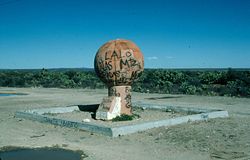Tropic of Cancer
2008/9 Schools Wikipedia Selection. Related subjects: Geography
The Tropic of Cancer, or Northern tropic, is one of five major circles of latitude that mark maps of the Earth. It is the northernmost latitude at which the Sun can appear directly overhead at noon. This event occurs at the June solstice, when the northern hemisphere is tilted towards the sun to its maximum extent.
The Tropic of Cancer currently lies 23° 26′ 22″ north of the Equator. North of this latitude are the subtropics and Northern Temperate Zone. The equivalent line of latitude south of the Equator is called the Tropic of Capricorn, and the region between the two, centered on the Equator, is known as the Tropics.
The line is called Tropic of Cancer because when it was named the sun was in the location of the constellation of Cancer (Latin for crab) in the sky at the June solstice. However, due to the precession of the equinoxes, the sun is now in the location of the constellation of Taurus at the June solstice. The word "tropic" itself comes from the Greek tropos, meaning turn, referring to the fact that the sun appears to "turn back" at the solstices.
The position of the Tropic of Cancer is not fixed, but varies in a complex manner over time; see under circles of latitude for information.
Geography

Starting at the Prime Meridian and heading eastwards, the Tropic of Cancer passes through:
-
Country, territory or sea Notes  Algeria
Algeria Niger
Niger Libya
LibyaThe Tropic touches on the northernmost point of  Chad
Chad Egypt
EgyptRed Sea  Saudi Arabia
Saudi Arabia United Arab Emirates
United Arab EmiratesAbu Dhabi emirate only  Oman
OmanIndian Ocean Arabian Sea  India
India Bangladesh
Bangladesh India
India Bangladesh
Bangladesh India
India Myanmar (Burma)
Myanmar (Burma) China
ChinaTaiwan Strait  Republic of China
Republic of ChinaTaiwan, claimed by  China
ChinaPacific Ocean  United States
United StatesHawaii — sea area only, misses every island, passing between Nihoa and Necker Island  Mexico
MexicoBaja California peninsula Gulf of California  Mexico
MexicoGulf of Mexico Straits of Florida  Bahamas
BahamasExuma Islands and Long Island Atlantic Ocean Western Sahara Claimed by  Morocco
Morocco Mauritania
Mauritania Mali
Mali Algeria
Algeria
Circumnavigation
According to the Fédération Aéronautique Internationale's rules, for a flight to compete for a round-the-world speed record, it must cover a distance no less than the length of the Tropic of Cancer as well as cross all meridians and end on the same airfield where it started. This length is set to be 36787.559 kilometres - a number implying a precision which does not exist, considering the variations of the tropic described above.
For an ordinary circumnavigation the rules are somewhat relaxed and the distance is set to a rounded value of 37000 kilometres.
